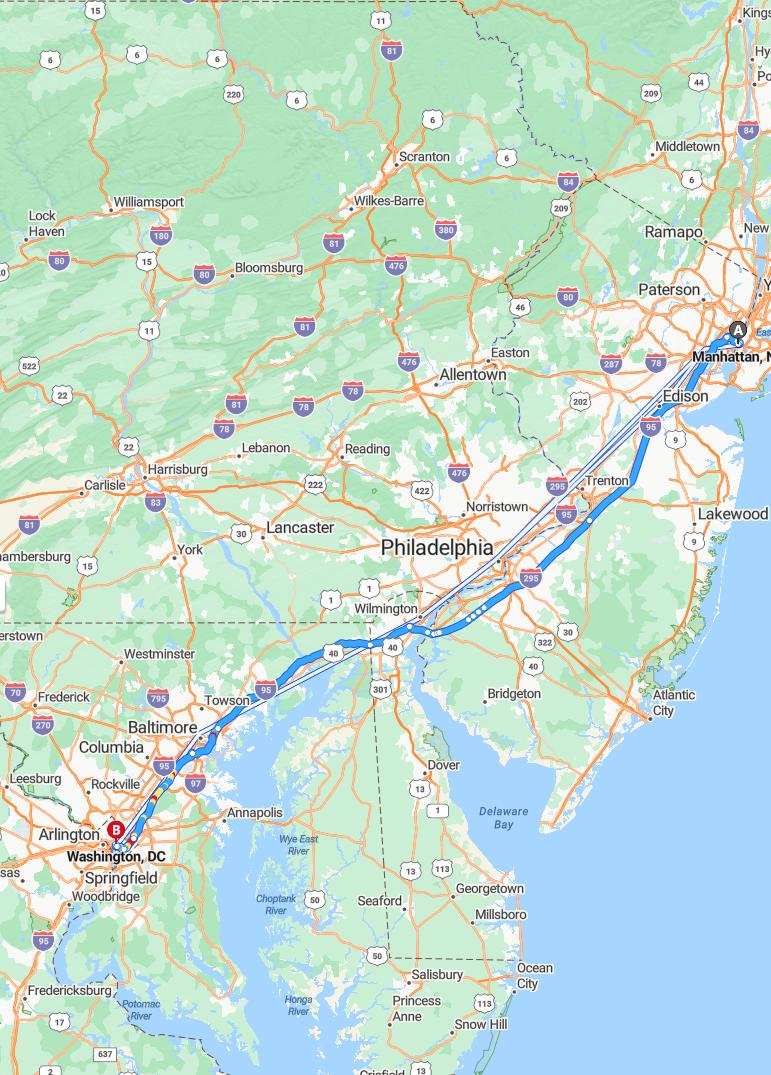Distance and estimated driving time
The drive from Manhattan to Washington typically takes around 4 hours and 5 minutes, covering approximately 230 miles. The most common route is via I-95 South, including the New Jersey Turnpike, which offers a direct and efficient path. Traffic conditions can vary, so it's wise to check real-time updates before your departure. Planning your trip accordingly can help ensure a smooth journey between these two major cities.
Driving route
Embarking on a drive from Manhattan to Washington, D.C., travelers often pass through several notable cities along the route. Starting in New York City, they head south toward Edison, known for its diverse communities and technological innovation. Continuing southwest, the journey proceeds through Trenton, the capital of New Jersey, rich in history and government institutions. As the route progresses, Wilmington, Delaware, offers a blend of historic sites and modern attractions before reaching the capital. This scenic and convenient corridor connects major urban centers, making it an efficient trip with ample opportunities to explore each city's unique cultural offerings.

Traffic conditions and peak hours
Driving from Manhattan to Washington typically involves navigating through several busy urban areas, with Wilmington, Philadelphia, and Trenton experiencing peak traffic during weekday rush hours from 7:00 to 9:00 AM in the morning and 4:00 to 7:00 PM in the evening. Philadelphia and New York City are known for heavy congestion, especially near downtown districts and during events or holidays, which can significantly delay travel times. Edison generally has lighter traffic, although it can become congested during peak hours when commuters travel to and from New Jersey. To ensure a smoother journey, travelers should consider avoiding peak times and checking live traffic updates, especially when passing through major metropolitan areas.
Rest stops and amenities along the route
As you drive from Manhattan to Washington, several rest stops and amenities are conveniently located along the route. In Wilmington, travelers can find various cafes and gas stations offering refreshments and fuel, making it a great place to stretch and refresh. Philadelphia provides numerous rest areas with clean facilities, food options, and amenities such as charging stations for electric vehicles. Continuing through Trenton, Edison, and into New York City, drivers can access urban parking garages, quick-service restaurants, and service stations to ensure a comfortable and convenient journey.
Cost of tolls and congestion charges
When driving from Manhattan to Washington, travelers will encounter various tolls and congestion charges along the route. In New York City, drivers face congestion charges and tolls on bridges and tunnels, which can significantly add to the total cost. As you pass through Wilmington, Philadelphia, Trenton, and Edison, additional tolls for highway crossings and bridges may apply, varying depending on the specific roads chosen. Planning ahead for these toll expenses can help manage travel costs effectively and avoid unexpected fees during the journey.
Best time to travel for avoiding traffic
The best time to drive from Manhattan to Washington to avoid heavy traffic is early in the morning, ideally between 5:00 and 7:00 am, when most commuters have not yet hit the roads. Traveling during mid-morning or early afternoon can also help, as traffic tends to thicken during rush hours from approximately 7:00 to 10:00 am and 4:00 to 7:00 pm, especially near major cities like Philadelphia, Trenton, and Wilmington. Planning your trip on weekends or during off-peak times, such as late evenings or early Sundays, can further reduce congestion. Using real-time traffic updates and navigation apps can help you adjust your departure time dynamically, ensuring a smoother drive through popular en route stops like Edison and New York City.
Alternative routes and their advantages
When traveling from Manhattan to Washington, D.C., alternative routes can enhance convenience and efficiency. Taking the I-95 corridor through Wilmington and Philadelphia offers a direct and speedy path, ideal for those prioritizing time. Alternatively, detouring through Trenton and Edison may provide less congested options during peak hours, reducing stress and delays. These variations allow travelers to choose routes based on current traffic conditions and personal preferences, ensuring a smoother journey.
Vehicle preparation and safety tips
Before embarking on a long drive from Manhattan to Washington, it is essential to prepare your vehicle to ensure safety and reliability. Check tire pressure, fluid levels, brakes, and lights to prevent unexpected breakdowns. Keep an emergency kit on hand, including items like a first-aid kit, flashlight, and basic tools, especially when traveling through cities such as Wilmington, Philadelphia, Trenton, Edison, and New York City. Additionally, plan your route ahead of time, stay alert, and take regular breaks to maintain focus and avoid fatigue during the journey.
Scenic viewpoints and attractions en route
As you journey from Manhattan to Washington, you'll encounter a variety of scenic viewpoints and attractions along the way. Wilmington offers beautiful riverfront parks and historic sites perfect for a quick stop, while Philadelphia features iconic landmarks like the Liberty Bell and Independence Hall, providing both historical insight and picturesque views. Trenton boasts scenic parks and the historic State House, ideal for a relaxing break, and Edison presents charming local neighborhoods and cultural attractions. Lastly, passing through New York City, you can enjoy stunning skyline vistas and bustling urban scenery, making the drive both visually captivating and enriching.
Parking options in Washington
Washington offers a variety of parking options to accommodate visitors and residents alike. Visitors can choose from numerous metered street parking spots in downtown areas, which are typically time-limited and available on a first-come, first-served basis. Additionally, there are several public parking garages and lots that provide hourly or daily rates, often located near major attractions and transit hubs. For added convenience, some areas also feature private parking facilities and validated parking options at shopping centers and event venues.
